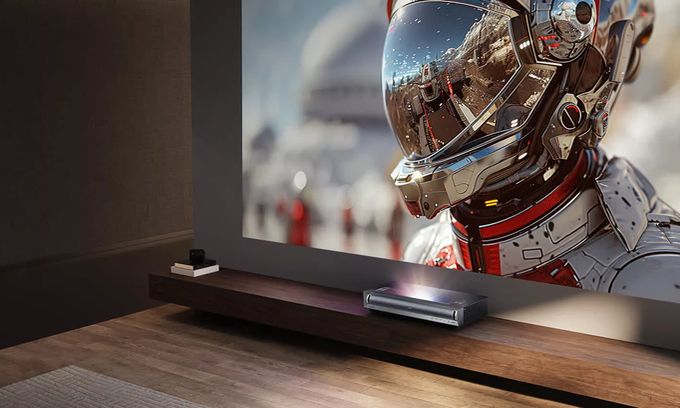The competition between 4K UST (ultra short throw) laser projectors and huge 100-inch TVs has been growing for several years now. On the one hand, TV manufacturers are successfully reducing prices, already offering some models for several thousand. Moreover, they are equipped with almost a full set of modern technologies, including, for example, a quantum dot technology (QD) – based display, FALD and even mini LED backlight in some 2024 models, wide smart functionality, and more. In turn, projector manufacturers also have significantly improved their products:
– high brightness and wide color gamut with ALPD (Advanced Laser Phosphor Display) – based light engine;
– 4K resolution with pixel shift-based XPR (Xpanded Pixel Resolution) technology in DLP DMD (Digital Light Processing and Digital Micromirror Device) chipset from Texas Instruments;
– UST design has eliminated one of the main problems of mid-focal projectors with wires on the floor. Today it can only be solved with a complex ceiling mount. UST models re-reflect the light flux using aspherical mirrors, creating a 100″ or larger image from a distance of only a few tens of inches. Accordingly, placing it next to the screen on the wall does not create this inconvenience.

Of course, their comparison is especially objectively for products from one manufacturer. This year, Chinese Hisense introduced the new PX3-Pro 4K laser UST projector, and relatively inexpensive 100-inches 100U8K & 100U76N TVs.
The PX3-Pro was announced at IFA (Internationale Funkausstellung Berlin) 2023 and replaces the PX2-PR (launch June 2023), which previously replaced the PX1-Pro (launch early 2022).
Hisense PX projectors
The series comes without a screen and is called ‘Laser Cinema’. The projectors have a variable focus lens and are compatible with screens of different sizes. As known, ‘Laser TV’ projectors come which a screen.
This division was due to a completely objective reason. Image quality depends significantly on the screen. Not wanting to risk their reputation, some industry leaders offered premium UST models only with screens. Of course, CLR (Ceiling Light Rejecting) screens are very effective, but they are expensive and significantly increase the price of the set.
But the consumer may already have a screen, inherit it, win it in a lottery, or buy it later, for example, after receiving a bonus. Therefore, many were skeptical about this idea. As a result, most companies refused to include a mandatory screen in the kit, offering them only as optional. Hisense has chosen to split its product lines into ‘Laser Cinema’ (without screen) and ‘Laser TV’ (more expensive models with screen) lines.
Today the PX ‘Laser Cinema’ series includes 1 Pro ($ 2,000), 2 Pro ($ 2,500) and 3 Pro ($ 3,500 or £ 2,500 or € 3,000).
The Hisense PX3-Pro with the perforated convex grille for the built-in speakers has a more stylish design compared to its predecessors.
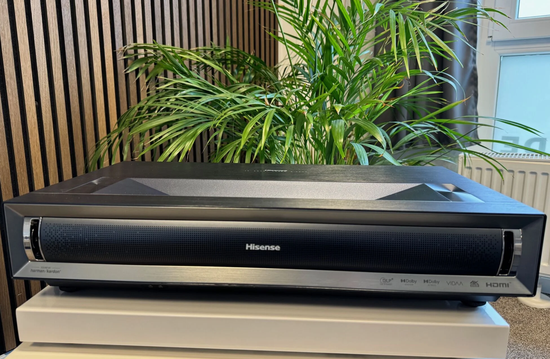
The four height-adjustable feet, digital image correction and adjustable focus simplify installation.
In addition to game mode with lower input lag, the model has a 1080p@240Hz mode with smoother visual effects due to a slight reduction in picture detail.
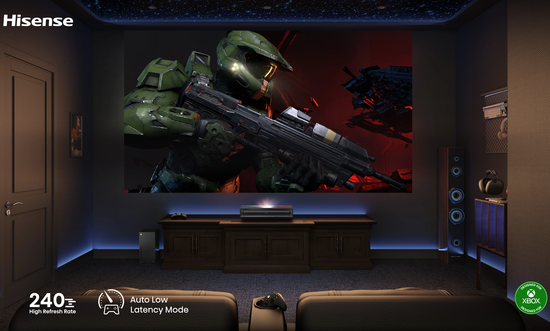
Unfortunately, playback of some scenes can sometimes be accompanied by the rainbow effect traditional for DLP technology. It appears as a halo along the contrasting contour. For reference, this problem does not exist in more expensive 3LCD and LCoS projectors.
Features
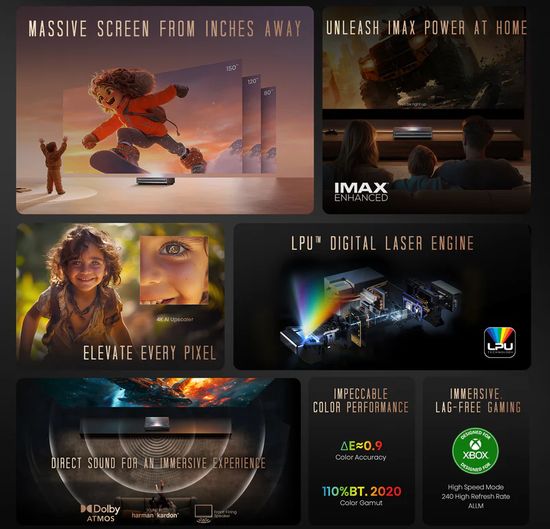
The focus range varies from 80″ to 150″ diagonally. Beyond these sizes, the image may not be clear. In previous PX models it’s only 130″. Throw Distance varies in the range of 0.2 m – 0.7 m with a Throw Ratio of 0.22:1 (~ 100″@0,5m). Accordingly, the developers also increased brightness from 2,200 / 2,400 to 3,000 ANSI Lumens (ANSI IT7.228 standard).
The audio system evolution is also impressive. The new version offers built-in 50W front-firing Harman Kardon-designed speakers instead of the previous 15W × 2 system.
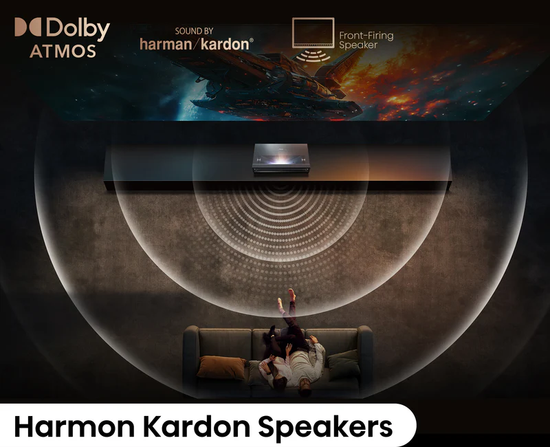
Of course, it also supports surround sound, including Dolby Atmos and Dolby Digital. They are loud enough and cover a wide range, including even the booming basses. The lack of side/rear/height channels slightly reduces the 3D surround effect. But it has an eARC (Enhanced Audio Return Channel) connector for transmitting full-resolution audio in digital format.
The 0.47″ DMD chipset with XPR (Xpanded Pixel Resolution) technology uses 4-phase pixel shift for playback of 4K Ultra HD (3,840 x 2,160) content.
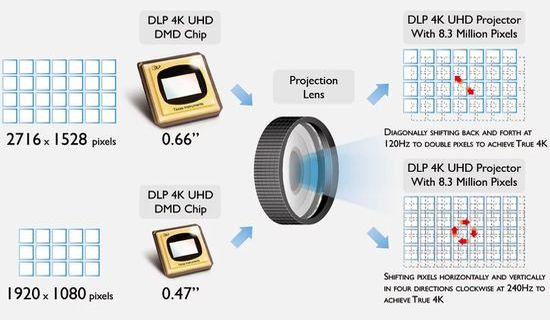
In addition, new Hisense’s Pro AI Algorithms optimizes brightness, contrast, and noise reduction in real time. Contrast is adjusted using a High Dynamic setting for Laser Luminance.
The model has a native contrast of 3000:1, Dolby Vision HDR compliance for Imax Enhanced content, and 1080p 3D support. The list of supported HDR formats includes HDR10+, HDR10, Dolby Vision and HLG. Of course, the model has popular MEMC motion compensation (smooth playback) and popular Filmmaker Mode.
Smart functionality includes Google TV (10,000+ apps), built-in WiFi, Bluetooth, Airplay and Apple Home, Google Assistant, works with Alexa. Google TV integration provides seamless access to streaming services, including Disney+, Netflix, Hulu, and Amazon Prime with support for IMAX Enhanced, HDR10+, and active 3D.
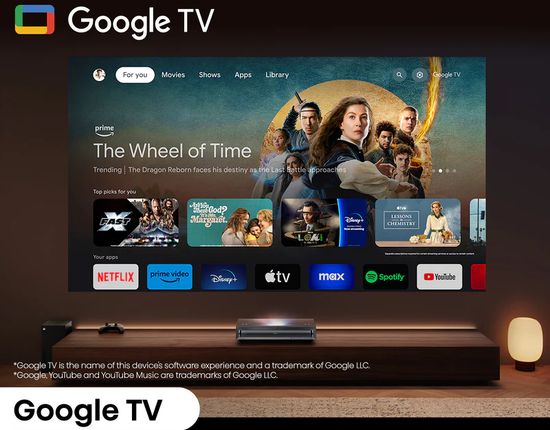
Hisense 2024 lineup
This year the Chinese giant presented two 100″ TVs with superb price-quality ratio:
– Hisense 100U76N – 2024, QLED display, Native 144Hz, Dolby Vision, FALD, Game Mode Pro, Alexa Compatibility – $ 2,200.
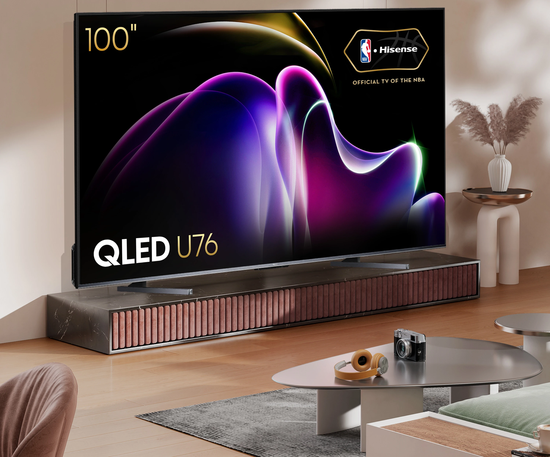
– Hisense 100U8K – 2024, QLED display, mini LED backlight with 1,620 local dimming zones, 480 Motion Rate, 144Hz Game Mode Pro, Dolby Vision IQ, HDMI 2.1, Alexa Compatibility, 50W 2.1.2ch audio system – $ 5,000.
The Hisense PX3-Pro costs $ 3,500.
TVs use an improved Hi-View Engine PRO chipset with Dynamic Tone Mapping Pro, Face Detection, AI HDR Enhancement, and AI Detail Enhancement support. They improve the display accuracy of skin tones, HDR detail, and the image detail. Except for minor details, the TV backlight is the main difference. The flagship 100U8K uses FALD (Full Array Local Dimming) with an innovative mini LED backlight. Tens of thousands of miniature LEDs are combined into one and a half thousand dimming zones with separate control. They provide a radical increase in the precision of intensity control in each zone depending on its content. As a result, the overall image contrast is comparable to the ‘infinite’ contrast of OLED panels. The ‘budget’ Hisense 100U76N has FALD with regular-sized LEDs that form 256 local dimming zones.
Hisense PX3-Pro also uses innovations. In particular, it’s equipped with the next-generation digital laser engine (LPU) using Hisense’s proprietary TriChroma triple-laser RGB technology. The developers were able to create a triple laser light engine with minimal laser speckle due to interference, which are a traditional problem of RGB light sourse. According to the company, X Fusion Laser Light Engine module can precisely control light on a nanoscale, providing a wider colour gamut (110% of the BT.2020 color space) and higher colour accuracy.
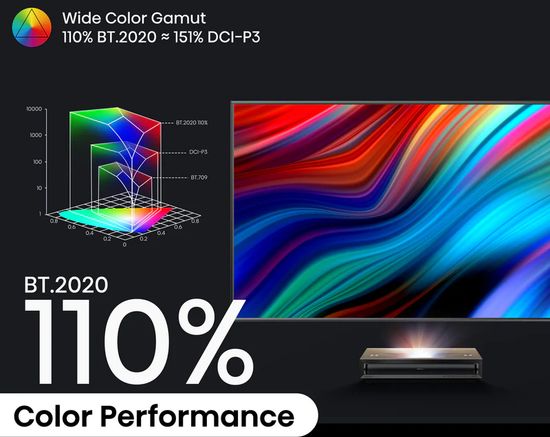
Hisense TVs vs PX3-Pro
In tests with a white screen and a gain of 1, the projector demonstrates a luminance of 26fL@3m in 4K HDR, which is less than 100 nits. For reference, foot-lambert (fL or ft-L) is a unit of measurement of the power of a directional luminous flux (1 fL = 3,4263 nit or cd/m²). For comparison, the Hisense 100U76N provides up to 800 nits peak brightness, and an average of several hundred nits SDR brightness. This difference is due to the partial loss of the projector’s light flux when reflected from the screen, as opposed to direct radiation from the TV screen surface. However, brightness is mainly required to compensate for ambient light. Therefore, the colors of a brighter TV are more saturated, for example, in diffused daylight. But in the evening twilight the difference practically disappears.
TV’s VA panel has ~4,000:1 native contrast, which increases to ~9,000:1 with local dimming on. PX3 Pro offers up to 3,000:1 native contrast (full on/off, from 2,560:1 in HDR Daytime to 2,940:1 in HDR Dynamic). TVs use an improved Hi-View Engine PRO chipset with Dynamic Tone Mapping Pro, Face Detection, AI HDR Enhancement, and AI Detail Enhancement support. They improve the display accuracy of skin tones, HDR detail, and the image detail.
PX3-Pro pros / cons
Pros
– 3,000 ANSI lumens brightness;
– 17.6 ms input lag;
– HDR – HDR10/HLG, HDR10+ and Dolby Vision support;
– integrated 50W Harman Kardon-designed speakers;
– 0.22:1 Throw Ratio (~ 100″@0,5m);
– smart TV functions (Netflix, Prime Video, Disney+, Apple TV, Max and more);
– built in-media player;
– multiple HDMI 2.1 sockets;
– 3D support;
– 1080p@240Hz mode for gaming.
Cons
– expensive;
– no built-in TV-tuner;
– remote without backlit;
– minor rainbow effect;
– slightly limited surround sound.
Conclusion
Thus, 100U76N is cheaper ($ 2,200 vs $ 3,500) and brighter, but its image size is 1.5 times smaller (100″ vs 150″ diagonally). However, the choice requires taking into account one more factor. The optimal viewing distance is approximately equal to the diagonal size multiplied by 1.2 (40° viewing angle). Accordingly, a 100″ screen requires a distance of 120″ / 3m, a 150-inch image is optimally perceived at a distance of 180″ / 4.5m. This may be a problem for some living rooms.
Comparison of the projector with the flagship Hisense 100U8K seems less relevant due to the too big difference in image quality. In fact, these devices belong to different classes.
So:
– Hisense 100U76N TV ($ 2,200) is an ideal budget option;
– 100U8K ($ 5,000) TV is suitable for high quality lovers with a good budget;
– Hisense PX3- Pro ($ 3,500) projector is a superb compromise, offering quite high quality on a huge 150-inches screen. But it requires a spacious living room of at least 5 meters in length.
This video shows the new Hisense PX3-Pro.
